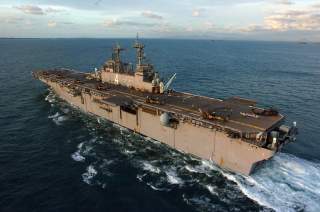Closer to War: U.S. Troops Aboard Amphibious Assault Ship Force Down Iranian Drone
What happens next?
U.S. troops aboard an amphibious assault ship on July 18, 2019 forced down an Iranian drone over the Strait of Hormuz, U.S. president Donald Trump announced.
The downing comes just a few weeks after Iranian forces downed an American drone in the same area. The mutual shoot-downs could escalate the already tense situation in the Persian Gulf region.
Trump said the unmanned aerial vehicle threatened USS Boxer.
Pentagon spokesman Jonathan Hoffman told The New York Times that Boxer was in international waters at the time of the incident. The drone “closed within a threatening range” before Boxer took action.
U.S. Marines embarked on Boxer used radio-jamming gear to bring down the drone, CNN reporter Ryan Browne tweeted.
“The drone was immediately destroyed,” Trump said.
It’s unclear what kind of drone the Marines forced down. Iran’s aviation industry produces a wide range of inexpensive UAVs, including several variants of the Mohajer drone that first entered service in the late 1980s.
Iranian forces in 2011 captured a secretive U.S. Air Force RQ-170 stealth spy drone. Tehran’s engineers reverse-engineered the batwing RQ-170 and produced crude copies of their own.
Tehran equipped the regime of Syrian president Bashar Al Assad with an array of UAVs.
Iran around a decade ago began arming some of its drone types with missiles and bombs. Iran Aviation Industries Organization in 2014 revealed a Mohajer variant that Iranian media claimed could shoot down other aircraft.
Just one day before Boxer downed the drone over the Strait of Hormuz, Iranian officials revealed a new model of the Mohajer. The Mohajer-6 “has the capability to carry out surveillance and reconnaissance missions, and enjoys a wide operational range and wingspan with a high precision,” state media reported.
“With the deployment of these unmanned aerial vehicles, any threat to the Iranian borders and even beyond the borders, will be identified, tracked down and removed before it could even take form,” said Brig. Gen. Hasannejad, commander of Iranian army drones.
The Mohajer-6 can carry guided munitions, state media claimed.
Tensions have escalated in the Middle East following Trump’s decision unilaterally to withdraw the United States from the 2015 deal limiting Iran’s nuclear program. After Trump restored economic sanctions, Tehran resumed stockpiling uranium.
Trump in the summer of 2019 ordered additional U.S. forces to the Middle East. Iranian missileers on June 20, 2019 shot down a U.S. Navy Global Hawk surveillance drone over the Strait of Hormuz.
American officials struck a defiant tone. Retired U.S. Air Force general David Deptula, dean of the Air Force Association’s Mitchell Institute, told Air Force magazine he would put an additional Global Hawk “in the exact same track.” “We certainly don’t want to be cowed,” Deptula said.
Clashes spread. Iranian boats on July 10, 2019 tried to “impede” the British oil tanker near the Strait of Hormuz, the BBC reported. HMS Montrose, a Type 23 frigate, “was forced to move between the three boats and the tanker,” according to the BBC.
The British government claimed the attacking boats belonged to the Iranian Revolutionary Guard Corps militia. The IRGC also allegedly was behind several recent bomb attacks targeting oil tankers in the Gulf and surrounding waters.
The July 2019 tanker incident compelled the Royal Navy to accelerate by several weeks a planned deployment to the Gulf by the Type 45 destroyer HMS Duncan. Montrose and Duncan together will patrol the Persian Gulf before Montrose returns to U.K. waters for maintenance.
Amid confrontations in the air and on the sea, Iran is taking steps to shorten the time it would take to produce a nuclear warhead.
Iran’s effort to shorten the time to produce a nuke “does not pose an immediate risk,” wrote Kelsey Davenport, an expert with the Arms Control Association in the United States.
“Currently, due to restrictions put in place by the nuclear deal, the United States estimates that timeline at 12 months,” Davenport explained.
David Axe serves as Defense Editor of the National Interest. He is the author of the graphic novels War Fix, War Is Boring and Machete Squad.

